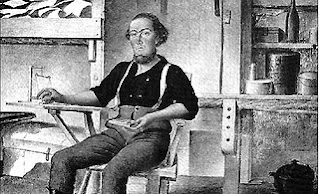Myths and Misnomers: Scalp Knives, War Paint and War Bonnets
 The scalp knife is a staple of Western movies and dime novels, as well as many early non-fiction accounts describing Natives. For example, observers of Osceola during his captivity at Fort Moultrie in 1838 noted that he was allowed to keep his "scalping knife" and had it clutched in his hand when he died. True, many Native tribes did practice scalping, and Osceola did so on one particular occasion. But they also engaged in other activities that would require a blade, combat or self defense, cleaning small game, making repairs to equipment or any other reasons a man might need a large utility knife while on the frontier or in the west. In fact, both Settlers, Natives and even some military men carried large utility knives in sheaths or stuck in their belts or sashes. Jim Bowie and his elder brother Rezin were famous for theirs. No one would have thought of calling the Bowie knife or its variations a scalping knife, unless it happened to belong to a Native American. The more neutral term for such knives is sheath knife.
The scalp knife is a staple of Western movies and dime novels, as well as many early non-fiction accounts describing Natives. For example, observers of Osceola during his captivity at Fort Moultrie in 1838 noted that he was allowed to keep his "scalping knife" and had it clutched in his hand when he died. True, many Native tribes did practice scalping, and Osceola did so on one particular occasion. But they also engaged in other activities that would require a blade, combat or self defense, cleaning small game, making repairs to equipment or any other reasons a man might need a large utility knife while on the frontier or in the west. In fact, both Settlers, Natives and even some military men carried large utility knives in sheaths or stuck in their belts or sashes. Jim Bowie and his elder brother Rezin were famous for theirs. No one would have thought of calling the Bowie knife or its variations a scalping knife, unless it happened to belong to a Native American. The more neutral term for such knives is sheath knife.Another erroneous description from Osceola's death bed describes him as painting his face, hands, and the handle of his knife in red, the color of death and war. True, red paint worn on the face or any other part of the body while in combat could symbolize blood and war, but the narrators erred in describing this as war paint. Many tribes painted their faces, bodies, their weapons and animals in time of war. However, they might also paint for other reasons. Preparing a body for death, such as Osceola was doing to himself, was an example. Others occasions were hunts, feasts, or rights of passage such as coming of age or marriage. Painting was reserved for special personal or religious reasons, and many leaders sat for their portraits without paint and not wearing war bonnets, such as Sitting Bull and Geronimo.
Finally, the war bonnet. Chiefs and ranking warriors among the Plains tribes wore them, especially the Sioux, Crow and Comanche, but not all the time. While some might have worn such headdresses into battle to denote bravery or rank, others reserved them for ceremonies and special occasions. Eastern Woodlands tribes, including those who had been forced west, such as the Seneca, Potawatomi and Seminoles, etc., never wore them. They may have worn other feathered headdresses at various times, but not a full-blown war bonnet. For war, Eastern tribes often shaved their heads or wore feathers fastened in their hair, as did Shawnee and Cherokee warriors. Only later, when posing for pictures for white photographers, did some Eastern Natives wear war bonnets because that's what the public expected a great Indian to look like.
(A different version of this post appeared in https://greatwarriorspath.blogspot.com).



Comments
Post a Comment